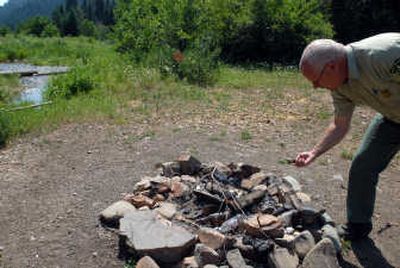Free camping’s steep cost

ENAVILLE, Idaho – The perfect camping spot sits less than an hour’s drive from Ron Coffelt’s home in Hayden.
A trout-filled mountain stream flows alongside the meadow where Coffelt and his family have camped each summer for nearly 30 years. And the price is right – it’s free.
But garbage and big-city crowds are beginning to ruin this grassy sliver of paradise. Bumblebee Meadows in the Idaho Panhandle National Forests has become a maze of deeply rutted paths. Piles of litter and five-gallon buckets of human waste lay hidden in the bushes behind many of the makeshift sites. On weekends, the meadow buzzes with motorcycles and all-terrain vehicles. Music thumps from some makeshift camps until dawn.
“This is probably going to be the last year,” Coffelt said, sitting on a lawn chair in front of his trailer on a recent afternoon. “The crowds and rowdiness are getting to be too much.”
Pitching a tent or parking a trailer in the national forest is not illegal, but some spots are being loved to death. Nowhere in the Inland Northwest is this more apparent than at Bumblebee Meadows, according to officials with the U.S. Forest Service. On weekends between Memorial and Labor days, the meadows along the Little North Fork of the Coeur d’Alene River are filled with dozens of tents and trailers.
Shoshone County Sheriff Chuck Reynalds said the overuse is becoming a public safety hazard. Because of the deeply rutted paths, ambulance drivers now refuse to drive into the meadows. A helicopter had to be used over Memorial Day weekend to fetch the victim of a drug overdose.
“It’s a huge problem,” Reynalds said. “I’d like to see the meadows closed until they can get it developed into a campground setting. … We have zero complaints with developed campgrounds.”
National forests across the region are struggling with similar problems of trying to keep forests open and accessible while protecting the environment from overuse, said Tom Knappenberger, spokesman for the Forest Service’s northwest region. The agency has no plans to halt the practice of free camping in national forests outside of developed campgrounds, he said. “It’s one of the beauties of the national forest system.”
But certain areas have been closed to give them a chance to recover. In May, dispersed camping was banned on parts of the East Fork of the Lewis River near Mount St. Helens.
Meadows along the Middle Fork of Calispell Creek in northeastern Washington have also been trashed in recent years by campers and through the illegal use of off-road vehicles, but the situation has improved recently thanks to the educational efforts of volunteers, said Debbie Wilkins, with the Colville National Forest. Although more people appear to be respecting the rules, Wilkins said all it takes is one or two irresponsible riders or campers to damage an area.
“It’s a rotational thing,” she said. “You might get one meadow rehabilitated, then all of a sudden somebody goes and tears it up.”
Officials with Idaho Panhandle National Forests are now trying to come up with a plan to get Bumblebee Meadows under control, as well as a growing number of heavily impacted dispersed camping sites along the North Fork of the Coeur d’Alene River. The amount of litter and illegal trails has gotten out of control, said District Ranger Randy Swick.
After Memorial Day weekend, for example, agency employees picked up 2,500 pounds of garbage from dispersed campsites in the area, Swick said. The trash included buckets of feces, as well as used furniture, building material and hundreds of beer bottles and cans.
Each weekend, it seems, new trails are cut through the national forest by off-road vehicle enthusiasts. Concrete barricades are pulled away by pickups.
“We’ve tried to put in every barricade you can imagine, but you just end up creating challenges for the riders,” Swick said on a recent afternoon, while surveying a hillside above Fernan Lake that was streaked with trails. Red “Off-limits” signs had been pounded into each of the trails. All had bullet holes or damage. “It’s almost like dangling a red blanket in front of a bull.”
The Forest Service is now in the process of clarifying where it’s appropriate for off-road vehicles to travel on public land. Next year, free maps are expected to be available showing these routes. Swick hopes the maps will help clarify the laws and reduce damage to the forest.
Work is also expected to begin later this summer on Bumblebee Meadows, Swick said. Some of the illegally created roads will be blocked off. Others will be covered with gravel to provide easier access for emergency vehicles. Further down the line, the Forest Service hopes to protect larger portions of the meadows from abuse – possibly by blocking off areas with massive boulders – while also ensuring accessibility to some of the makeshift camping spots, Swick said.
“We want to encourage folks to go into the woods, but we’re starting to see some hefty impacts,” he said.
Last week, Brandee Willette, a bartender from Coeur d’Alene, pitched her tent on the edge of Bumblebee Meadows, about 50 feet from the river. She’s been camping here for free since she was a little girl. Now, she’s bringing her two young children to the area.
Willette has no desire to camp in a formal campground. “Too many rules,” she said.
Besides, $12 a night can add up after a few nights, Willette said, while keeping close watch on a trio of hamburgers she was grilling. Her children splashed in the river nearby. Although Willette shudders at the thought of having to pay to camp, she agreed that the meadows are getting out of control.
Old string cheese wrappers, cigarette butts, dirty diapers and dozens of beer cans had been strewn across the forest floor behind Willette’s site.
“Something needs to be done to keep this place clean,” she said.